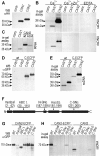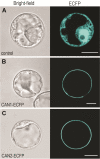Plant plasma membrane-bound staphylococcal-like DNases as a novel class of eukaryotic nucleases
- PMID: 23102437
- PMCID: PMC3505149
- DOI: 10.1186/1471-2229-12-195
Plant plasma membrane-bound staphylococcal-like DNases as a novel class of eukaryotic nucleases
Abstract
Background: The activity of degradative nucleases responsible for genomic DNA digestion has been observed in all kingdoms of life. It is believed that the main function of DNA degradation occurring during plant programmed cell death is redistribution of nucleic acid derived products such as nitrogen, phosphorus and nucleotide bases. Plant degradative nucleases that have been studied so far belong mainly to the S1-type family and were identified in cellular compartments containing nucleic acids or in the organelles where they are stored before final application. However, the explanation of how degraded DNA components are exported from the dying cells for further reutilization remains open.
Results: Bioinformatic and experimental data presented in this paper indicate that two Arabidopsis staphylococcal-like nucleases, named CAN1 and CAN2, are anchored to the cell membrane via N-terminal myristoylation and palmitoylation modifications. Both proteins possess a unique hybrid structure in their catalytic domain consisting of staphylococcal nuclease-like and tRNA synthetase anticodon binding-like motifs. They are neutral, Ca2+-dependent nucleaces showing a different specificity toward the ssDNA, dsDNA and RNA substrates. A study of microarray experiments and endogenous nuclease activity revealed that expression of CAN1 gene correlates with different forms of programmed cell death, while the CAN2 gene is constitutively expressed.
Conclusions: In this paper we present evidence showing that two plant staphylococcal-like nucleases belong to a new, as yet unidentified class of eukaryotic nucleases, characterized by unique plasma membrane localization. The identification of this class of nucleases indicates that plant cells possess additional, so far uncharacterized, mechanisms responsible for DNA and RNA degradation. The potential functions of these nucleases in relation to their unique intracellular location are discussed.
Figures








Similar articles
-
The plant s1-like nuclease family has evolved a highly diverse range of catalytic capabilities.Plant Cell Physiol. 2013 Jul;54(7):1064-78. doi: 10.1093/pcp/pct061. Epub 2013 Apr 24. Plant Cell Physiol. 2013. PMID: 23620482
-
Subcellular localization and functional analysis of the Arabidopsis GTPase RabE.Plant Physiol. 2009 Apr;149(4):1824-37. doi: 10.1104/pp.108.132092. Epub 2009 Feb 20. Plant Physiol. 2009. PMID: 19233904 Free PMC article.
-
Prokaryotic homologs of Argonaute proteins are predicted to function as key components of a novel system of defense against mobile genetic elements.Biol Direct. 2009 Aug 25;4:29. doi: 10.1186/1745-6150-4-29. Biol Direct. 2009. PMID: 19706170 Free PMC article.
-
Nucleases in higher plants and their possible involvement in DNA degradation during leaf senescence.J Exp Bot. 2014 Jul;65(14):3835-43. doi: 10.1093/jxb/eru091. Epub 2014 Mar 14. J Exp Bot. 2014. PMID: 24634485 Review.
-
Origins of Programmable Nucleases for Genome Engineering.J Mol Biol. 2016 Feb 27;428(5 Pt B):963-89. doi: 10.1016/j.jmb.2015.10.014. Epub 2015 Oct 23. J Mol Biol. 2016. PMID: 26506267 Free PMC article. Review.
Cited by
-
Protein S-acyltransferases and acyl protein thioesterases, regulation executors of protein S-acylation in plants.Front Plant Sci. 2022 Jul 27;13:956231. doi: 10.3389/fpls.2022.956231. eCollection 2022. Front Plant Sci. 2022. PMID: 35968095 Free PMC article. Review.
-
Palmitoylation in plants: new insights through proteomics.Plant Signal Behav. 2013 Aug;8(8):e25209. doi: 10.4161/psb.25209. Epub 2013 Jun 5. Plant Signal Behav. 2013. PMID: 23759553 Free PMC article.
-
Phylogenetic Analysis and In Vitro Bifunctional Nuclease Assay of Arabidopsis BBD1 and BBD2.Molecules. 2020 May 6;25(9):2169. doi: 10.3390/molecules25092169. Molecules. 2020. PMID: 32384799 Free PMC article.
-
The role of lipid post-translational modification in plant developmental processes.Front Plant Sci. 2014 Feb 18;5:50. doi: 10.3389/fpls.2014.00050. eCollection 2014. Front Plant Sci. 2014. PMID: 24600462 Free PMC article. Review.
-
Ca2+-dependent nuclease is involved in DNA degradation during the formation of the secretory cavity by programmed cell death in fruit of Citrus grandis 'Tomentosa'.J Exp Bot. 2020 Aug 6;71(16):4812-4827. doi: 10.1093/jxb/eraa199. J Exp Bot. 2020. PMID: 32324220 Free PMC article.
References
-
- Guo Y, Cai Z, Gan S. Transcriptome of Arabidopsis leaf senescence. Plant Cell Environ. 2004;27:521–549. doi: 10.1111/j.1365-3040.2003.01158.x. - DOI
Publication types
MeSH terms
Substances
LinkOut - more resources
Full Text Sources
Molecular Biology Databases
Miscellaneous

